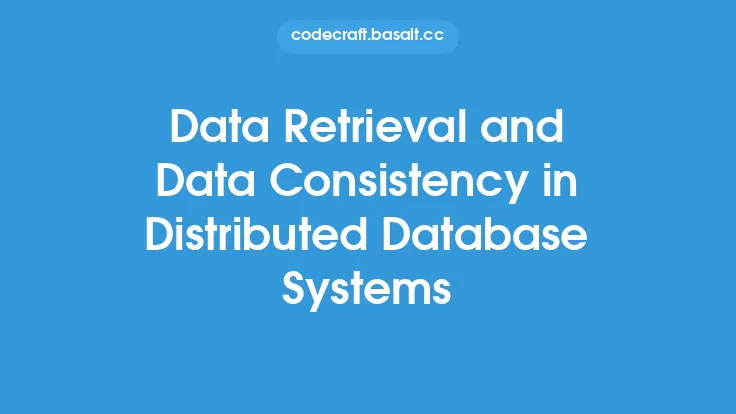Database systems are designed to store and manage large amounts of data, and one of the primary functions of these systems is to retrieve data in a efficient and effective manner. Data retrieval is the process of accessing and extracting data from a database, and it is a fundamental concept in database systems. In this article, we will explore the fundamentals of data retrieval in database systems, including the different types of data retrieval, the components involved in the data retrieval process, and the techniques used to optimize data retrieval.
Introduction to Data Retrieval
Data retrieval is the process of accessing and extracting data from a database. It involves querying the database to retrieve specific data, and the database management system (DBMS) plays a crucial role in this process. The DBMS provides a interface for users to interact with the database, and it manages the data retrieval process to ensure that the data is retrieved efficiently and accurately. There are several types of data retrieval, including simple retrieval, complex retrieval, and retrieval using indexes. Simple retrieval involves retrieving a single record or a set of records based on a specific condition, while complex retrieval involves retrieving data based on multiple conditions or using aggregate functions. Retrieval using indexes involves using pre-computed indexes to speed up the data retrieval process.
Components Involved in Data Retrieval
The data retrieval process involves several components, including the database management system (DBMS), the database schema, and the query language. The DBMS is responsible for managing the data retrieval process, and it provides a interface for users to interact with the database. The database schema defines the structure of the database, including the relationships between different tables and the data types of each column. The query language is used to specify the data retrieval request, and it provides a way for users to interact with the database. The most common query language used in database systems is SQL (Structured Query Language), which provides a standard way of accessing and manipulating data in a database.
Query Processing
Query processing is the process of analyzing and executing a query to retrieve data from a database. It involves several steps, including query parsing, query optimization, and query execution. Query parsing involves breaking down the query into its component parts, such as the SELECT clause, the FROM clause, and the WHERE clause. Query optimization involves analyzing the query to determine the most efficient way to execute it, and it may involve reordering the operations or using indexes to speed up the process. Query execution involves executing the optimized query plan to retrieve the required data. The query execution process may involve accessing multiple tables, joining tables, and applying aggregate functions to the data.
Indexing and Data Retrieval
Indexing is a technique used to speed up the data retrieval process by providing a quick way to locate specific data. An index is a data structure that contains a copy of selected columns from a table, along with a pointer to the location of the corresponding rows in the table. Indexes can be created on one or more columns of a table, and they can be used to speed up queries that filter data based on those columns. There are several types of indexes, including B-tree indexes, hash indexes, and full-text indexes. B-tree indexes are the most common type of index, and they provide a way to efficiently locate data in a table. Hash indexes are used to speed up queries that involve equality comparisons, while full-text indexes are used to speed up queries that involve searching for specific text patterns.
Data Retrieval Techniques
There are several techniques used to optimize data retrieval in database systems, including caching, buffering, and parallel processing. Caching involves storing frequently accessed data in a cache, which provides a quick way to access the data without having to retrieve it from the database. Buffering involves storing data in a buffer, which provides a way to temporarily store data while it is being processed. Parallel processing involves dividing the data retrieval process into smaller tasks that can be executed concurrently, which provides a way to speed up the process by utilizing multiple processors or cores.
Conclusion
In conclusion, data retrieval is a fundamental concept in database systems, and it involves accessing and extracting data from a database. The data retrieval process involves several components, including the DBMS, the database schema, and the query language. Query processing is the process of analyzing and executing a query to retrieve data from a database, and it involves several steps, including query parsing, query optimization, and query execution. Indexing is a technique used to speed up the data retrieval process, and there are several types of indexes, including B-tree indexes, hash indexes, and full-text indexes. Finally, there are several techniques used to optimize data retrieval, including caching, buffering, and parallel processing. By understanding the fundamentals of data retrieval, developers and database administrators can design and implement efficient and effective data retrieval systems that meet the needs of their applications.





